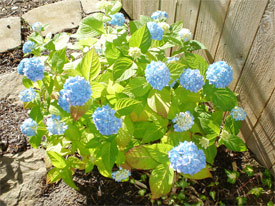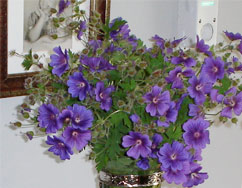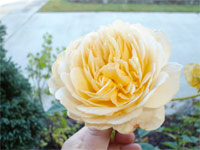For sustainable, local fresh flowers, it’s DIY
As foodies, a trip to the grocery store or market is a delight to the senses. So much so that little luxuries seem to jump right in the basket. . .a fine aged cheese, a bottle of wine, flowers. Ah, the flowers. . .what represents the “the good life” more than a home filled with cut flowers?
For us, a good price meant the flowers would end up in the basket. We have been buying small farm meat and fair trade coffee for quite some time, but it took us a while to apply the same standards to flowers. Like food, cut flowers are subject to political issues.

Flowers are rarely local—with the exception of California and Florida, the US imports nearly 90% of its cut flowers from central and South America (Tulips still come from the Netherlands). Though the carbon footprint alone of a bouquet gives one pause, working conditions for growers is another issue, as is the pesticide-filled waste-water that is a negative by-product of most flower production. The FDA does not oversee flower crops, and since they are not foods, little attention is given to the types of chemicals used to treat them. The US has stringent policies against bringing pests into the country, which unwittingly encourages the use of harsh pesticides. Check out this article, Cut the Toxins, Buy Organic on the downside of store bought cut flowers for some more detailed information. If you look for Fair Trade or Veriflora Certified flowers, you can at least be certain that sustainability is a priority. But what about local? Farmer’s markets are great sources for local cut flowers, and if you have neither the time nor inclination to make a flower garden, a wonderful alternative, although not cheap.
We decided that since we love to garden anyway, creating an old-fashioned cutting garden would be the best way to satisfy both our senses and our budget. We may supplement here and there with annuals, like sunflowers and zinnias and petunias, but the backbone of the garden consists of perennial flowers and shrubs. The creation of our cutting garden did require an initial investment (picking up end of the season plants for next year’s blooming season and dividing rootbound, pitiful looking nursery plants are great moneysavers!), but everything comes back, year after year. Our cutting garden is now about 2 years old, created from the ground up in a former scraggly side yard. As it continues to mature, it will only become more and more lush: many plants will be divided and many will self-seed. Not only is the garden beautiful from the street and our windows, we have bouquets to gather just out the door. In addition, it attracts bees galore, butterflies and hummingbirds. Check out the slide show of our early summer garden.

Spring to very early summer brings hellebores, tulips, daffodils, crocus, hyacinths, ranuculus, lungwort, Jacob’s ladder, bleeding heart, dianthus, peonies, lilac, hardy geranium and poppies. Summer proper sees the advent of cosmos, calla lilies, lupine, clematis, loosestrife, yarrow, iris, euphorbia, foxglove, calla lilies and roses. Midsummer brings acanthus, allium, coreopsis, heuchera, gaura, gaillardia, gladiolus, echinacia, phlox, rudebeckia, delphinium, cannas, begonias, hibiscus, jasmine, honeysuckle and passionflower. The herb garden flowers on and off through spring and summer—and mint, oregano, sage, rosemary and chives are beautiful additions to bouquets. (Although once Lisa added flat-leaf parsley to a bouquet, only to find that Nicole eventually nibbled away the greenery on multiple walk-bys!) Asters, dahlias, lilies, heathers, crocosmia, butterfly bushes and Japanese anemones peak in late summer and continue well into the fall here in Portland. Have a cutting garden changes your vision—you’re on the lookout for any interesting plant, and suddenly you appreciate your shrubs more than before. The burgundy hues of our smokebush and its misty blooms provide contrast to pale yellow and pink roses in bouquets. As winter approaches, we started finding beauty in the winter landscape as well. Camellia and photinia foliage provided green in the dead of winter and red and yellow twig dogwood stems added vibrant color. Dried grass seed heads and thistles add interesting form. In the late winter and very early spring we bring in witch hazel and daphne, not only beautiful but wonderfully fragrant.

We have found that our cutting garden feeds the senses and the soul with beauty, perhaps as important as feeding the body with nutritious whole foods from the vegetable garden.
Next week, TwoJunes explore the hidden cost of “keeping house”—the constant struggle against the complete and utter return to nature that occupies “civilized” folks.
Lisa Bell is a freelance producer, writer and editor. She spent the first fifteen years of her working life as a pastry chef, recipe developer, test kitchen director, food stylist and print editor. She has also taught cooking classes, run a small cooking school, and worked as a food scientist. Nicole Rees currently works as a baking scientist. She is also a food writer and cookbook author specializing in baking science. Her most recent book Baking Unplugged, is filled with simple, scratch recipes that require no electric gadgets beyond an oven.

